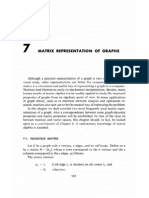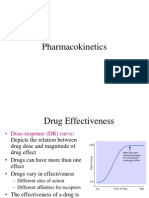11graph Algorithms
Uploaded by
Kumar Sumeet11graph Algorithms
Uploaded by
Kumar SumeetGraph Algorithms
Graph Algorithms
Graph Theory is an area of mathematics that deals with following types of problems
q q q q q
Connection problems Scheduling problems Transportation problems Network analysis Games and Puzzles.
The Graph Theory has important applications in Critical path analysis, Social psychology, Matrix theory, Set theory, Topology, Group theory, Molecular chemistry, and Searching. Those who would like to take a quick tour of essentials of graph theory please go directly to "Graph Theory" from here.
Digraph
A directed graph, or digraph G consists of a finite nonempty set of vertices V, and a finite set of edges E, where an edge is an ordered pair of vertices in V. Vertices are also commonly referred to as nodes. Edges are sometimes referred to as arcs. As an example, we could define a graph G=(V, E) as follows: V = {1, 2, 3, 4} E = { (1, 2), (2, 4), (4, 2) (4, 1)} Here is a pictorial representation of this graph.
http://www.personal.kent.edu/~rmuhamma/Algorithms/MyAlgorithms/GraphAlgor/graphIntro.htm (1 of 7)2/24/2006 8:54:46 PM
Graph Algorithms
The definition of graph implies that a graph can be drawn just knowing its vertex-set and its edgeset. For example, our first example
has vertex set V and edge set E where: V = {1,2,3,4} and E = {(1,2),(2,4),(4,3),(3,1),(1,4),(2,1), (4,2),(3,4),(1,3),(4,1). Notice that each edge seems to be listed twice. Another example, the following Petersen Graph G=(V,E) has vertex set V and edge set E where: V = {1,2,3,4}and E ={(1,2),(2,4),(4,3),(3,1),(1,4),(2,1),(4,2),(3,4),(1,3),(4,1)}.
http://www.personal.kent.edu/~rmuhamma/Algorithms/MyAlgorithms/GraphAlgor/graphIntro.htm (2 of 7)2/24/2006 8:54:46 PM
Graph Algorithms
We'll quickly covers following three important topics from algorithmic perspective.
1. Transpose 2. Square 3. Incidence Matrix
1. Transpose
If graph G = (V, E) is a directed graph, its transpose, GT = (V, ET) is the same as graph G with all arrows reversed. We define the transpose of a adjacency matrix A = (aij) to be the adjacency matrix AT = (Taij) given by Taij = aji. In other words, rows of matrix A become columns of matrix AT and columns of matrix A becomes rows of matrix AT. Since in an undirected graph, (u, v) and (v, u) represented the same edge, the adjacency matrix A of an undirected graph is its own transpose: A = AT.
http://www.personal.kent.edu/~rmuhamma/Algorithms/MyAlgorithms/GraphAlgor/graphIntro.htm (3 of 7)2/24/2006 8:54:46 PM
Graph Algorithms
Formally, the transpose of a directed graph G = (V, E) is the graph GT (V, ET), where ET = {(u, v) VV : (u, v)E. Thus, GT is G with all its edges reversed. We can compute GT from G in the adjacency matrix representations and adjacency list representations of graph G. Algorithm for computing GT from G in representation of graph G is
ALGORITHM MATRIX TRANSPOSE (G, GT) For i = 0 to i < V[G] For j = 0 to j V[G] GT (j, i) = G(i, j) j = j + 1; i=i+1
To see why it works notice that if GT(i, j) is equal to G(j, i), the same thing is achieved. The time complexity is clearly O(V2).
Algorithm for Computing GT from G in Adjacency-List Representation
In this representation, a new adjacency list must be constructed for transpose of G. Every list in adjacency list is scanned. While scanning adjacency list of v (say), if we encounter u, we put v in adjacency-list of u.
ALGORITHM LIST TRANSPOSE [G] for u = 1 to V[G] for each element vAdj[u] Insert u into the front of Adj[v]
http://www.personal.kent.edu/~rmuhamma/Algorithms/MyAlgorithms/GraphAlgor/graphIntro.htm (4 of 7)2/24/2006 8:54:46 PM
Graph Algorithms
To see why it works, notice if an edge exists from u to v, i.e., v is in the adjacency list of u, then u is present in the adjacency list of v in the transpose of G.
2. Square
The square of a directed graph G = (V, E) is the graph G2 = (V, E2) such that (a, b)E2 if and only if for some vertex cV, both (u, c)E and (c,b)E. That is, G2 contains an edge between vertex a and vertex b whenever G contains a path with exactly two edges between vertex a and vertex b.
Algorithms for Computing G2 from G in the Adjacency-List Representation of G Create a new array Adj'(A), indexed by V[G] For each v in V[G] do For each u in Adj[v] do \\ v has a path of length 2. \\ to each of the neighbors of u make a copy of Adj[u] and append it to Adj'[v] Return Adj'(A).
For each vertex, we must make a copy of at most |E| list elements. The total time is O(|V| * |E|).
Algorithm for Computing G2 from G in the Adjacency-Matrix representation of G.
http://www.personal.kent.edu/~rmuhamma/Algorithms/MyAlgorithms/GraphAlgor/graphIntro.htm (5 of 7)2/24/2006 8:54:46 PM
Graph Algorithms
For i = 1 to V[G] For j = 1 to V[G] For k = 1 to V[G] c[i, j] = c[i, j] + c[i, k] * c[k, j]
Because of three nested loops, the running time is O(V3).
3. Incidence Matrix
The incidence matrix of a directed graph G=(V, E) is a VE matrix B = (bij) such that
-1 b = 1
ij
if edge j leaves vertex j. if edge j enters vertex j. otherwise.
If B is the incidence matrix and BT is its transpose, the diagonal of the product matrix BBT represents the degree of all the nodes, i.e., if P is the product matrix BBT then P[i, j] represents the degree of node i: Specifically we have
BBT(i,j) = e
Now,
q
bie bTej = e E bie b je E
If i If i
= j, then biebje = 1, whenever edge e enters or leaves vertex i and 0 otherwise. j, then biebje = -1, when e = (i, j) or e = (j, i) and 0 otherwise.
http://www.personal.kent.edu/~rmuhamma/Algorithms/MyAlgorithms/GraphAlgor/graphIntro.htm (6 of 7)2/24/2006 8:54:46 PM
Graph Algorithms
Therefore
BBT(i,j) = deg(i) = in_deg + Out_deg = -(# of edges connecting i an j ) j
if i = j if i
http://www.personal.kent.edu/~rmuhamma/Algorithms/MyAlgorithms/GraphAlgor/graphIntro.htm (7 of 7)2/24/2006 8:54:46 PM
You might also like
- Basic Principles of Drug Discovery and Development 2nd Edition 2021 Benjamin E. Blass All Chapters Instant Download100% (3)Basic Principles of Drug Discovery and Development 2nd Edition 2021 Benjamin E. Blass All Chapters Instant Download50 pages
- Fuzzy and Rough Approximations Operations On Graphs: M. ShokryNo ratings yetFuzzy and Rough Approximations Operations On Graphs: M. Shokry7 pages
- CS 510 - Algorithms Exercise 22.1-1 Given An Adjacency-List Representation100% (2)CS 510 - Algorithms Exercise 22.1-1 Given An Adjacency-List Representation4 pages
- Efficient Frequent Connected Induced Subgraph Mining in Graphs of Bounded Tree-WidthNo ratings yetEfficient Frequent Connected Induced Subgraph Mining in Graphs of Bounded Tree-Width16 pages
- Computing With Graphs and Groups: Leonard H. SoicherNo ratings yetComputing With Graphs and Groups: Leonard H. Soicher20 pages
- Graphs in Data Structure Using C ProgrammingNo ratings yetGraphs in Data Structure Using C Programming79 pages
- ApplicationsOfGraphTheoryInLinearAlgebraNo ratings yetApplicationsOfGraphTheoryInLinearAlgebra11 pages
- Louis H. Kauffman - Notes On Diagrammatic Matrix Algebra and GraphsNo ratings yetLouis H. Kauffman - Notes On Diagrammatic Matrix Algebra and Graphs12 pages
- SAT-Based Loop Detection in Graph RewritingNo ratings yetSAT-Based Loop Detection in Graph Rewriting5 pages
- Design & Analysis of Algorithms: Lecture#10 Graph Introduction, BFT, DFT, MST, Shortest PathNo ratings yetDesign & Analysis of Algorithms: Lecture#10 Graph Introduction, BFT, DFT, MST, Shortest Path115 pages
- UNO1997 Algorithms For Enumerating All Perfect Maximum and Maximal Matchings in Bipartite GraphsNo ratings yetUNO1997 Algorithms For Enumerating All Perfect Maximum and Maximal Matchings in Bipartite Graphs10 pages
- Math 7400 Graph Theory: Bogdan OporowskiNo ratings yetMath 7400 Graph Theory: Bogdan Oporowski213 pages
- Generalized order divisor graphs associated with finite groupsNo ratings yetGeneralized order divisor graphs associated with finite groups11 pages
- Miklos Bartha and Miklos Kresz - Deciding The Deterministic Property For Soliton GraphsNo ratings yetMiklos Bartha and Miklos Kresz - Deciding The Deterministic Property For Soliton Graphs16 pages
- 20.previous Year GATE Questions (With Solutions)No ratings yet20.previous Year GATE Questions (With Solutions)32 pages
- Two Dimensional Computer Graphics: Exploring the Visual Realm: Two Dimensional Computer Graphics in Computer VisionFrom EverandTwo Dimensional Computer Graphics: Exploring the Visual Realm: Two Dimensional Computer Graphics in Computer VisionNo ratings yet
- Session02. Advanced Baseline Development (1 of 4)No ratings yetSession02. Advanced Baseline Development (1 of 4)58 pages
- RGB Color Table: Color HTML / Css Name Hex Code #RRGGBB Decimal Code (R, G, B)No ratings yetRGB Color Table: Color HTML / Css Name Hex Code #RRGGBB Decimal Code (R, G, B)5 pages
- Managing Correctable Memory Errors On Cisco UCS Servers: White PaperNo ratings yetManaging Correctable Memory Errors On Cisco UCS Servers: White Paper9 pages
- Comprehensive Risk Management in Horizontal Directional Drilling Projects100% (1)Comprehensive Risk Management in Horizontal Directional Drilling Projects11 pages
- Level Top PC-AGG: Polishable Self-Leveling Overlayment With Natural AggregateNo ratings yetLevel Top PC-AGG: Polishable Self-Leveling Overlayment With Natural Aggregate3 pages
- PET Practice R&W - AnhDaChuyenSangFileDocRoi PDFNo ratings yetPET Practice R&W - AnhDaChuyenSangFileDocRoi PDF8 pages
- 46) UB356X171X51 To RHS250X150X10-B2CW - MC - CLR-14No ratings yet46) UB356X171X51 To RHS250X150X10-B2CW - MC - CLR-14124 pages
- Full Download Serious Cycling 2nd Edition Edmund R. Burke PDF DOCX100% (15)Full Download Serious Cycling 2nd Edition Edmund R. Burke PDF DOCX60 pages
- Basic Principles of Drug Discovery and Development 2nd Edition 2021 Benjamin E. Blass All Chapters Instant DownloadBasic Principles of Drug Discovery and Development 2nd Edition 2021 Benjamin E. Blass All Chapters Instant Download
- Fuzzy and Rough Approximations Operations On Graphs: M. ShokryFuzzy and Rough Approximations Operations On Graphs: M. Shokry
- CS 510 - Algorithms Exercise 22.1-1 Given An Adjacency-List RepresentationCS 510 - Algorithms Exercise 22.1-1 Given An Adjacency-List Representation
- Efficient Frequent Connected Induced Subgraph Mining in Graphs of Bounded Tree-WidthEfficient Frequent Connected Induced Subgraph Mining in Graphs of Bounded Tree-Width
- Computing With Graphs and Groups: Leonard H. SoicherComputing With Graphs and Groups: Leonard H. Soicher
- Louis H. Kauffman - Notes On Diagrammatic Matrix Algebra and GraphsLouis H. Kauffman - Notes On Diagrammatic Matrix Algebra and Graphs
- Design & Analysis of Algorithms: Lecture#10 Graph Introduction, BFT, DFT, MST, Shortest PathDesign & Analysis of Algorithms: Lecture#10 Graph Introduction, BFT, DFT, MST, Shortest Path
- UNO1997 Algorithms For Enumerating All Perfect Maximum and Maximal Matchings in Bipartite GraphsUNO1997 Algorithms For Enumerating All Perfect Maximum and Maximal Matchings in Bipartite Graphs
- Generalized order divisor graphs associated with finite groupsGeneralized order divisor graphs associated with finite groups
- Miklos Bartha and Miklos Kresz - Deciding The Deterministic Property For Soliton GraphsMiklos Bartha and Miklos Kresz - Deciding The Deterministic Property For Soliton Graphs
- Two Dimensional Computer Graphics: Exploring the Visual Realm: Two Dimensional Computer Graphics in Computer VisionFrom EverandTwo Dimensional Computer Graphics: Exploring the Visual Realm: Two Dimensional Computer Graphics in Computer Vision
- RGB Color Table: Color HTML / Css Name Hex Code #RRGGBB Decimal Code (R, G, B)RGB Color Table: Color HTML / Css Name Hex Code #RRGGBB Decimal Code (R, G, B)
- Managing Correctable Memory Errors On Cisco UCS Servers: White PaperManaging Correctable Memory Errors On Cisco UCS Servers: White Paper
- Comprehensive Risk Management in Horizontal Directional Drilling ProjectsComprehensive Risk Management in Horizontal Directional Drilling Projects
- Level Top PC-AGG: Polishable Self-Leveling Overlayment With Natural AggregateLevel Top PC-AGG: Polishable Self-Leveling Overlayment With Natural Aggregate
- 46) UB356X171X51 To RHS250X150X10-B2CW - MC - CLR-1446) UB356X171X51 To RHS250X150X10-B2CW - MC - CLR-14
- Full Download Serious Cycling 2nd Edition Edmund R. Burke PDF DOCXFull Download Serious Cycling 2nd Edition Edmund R. Burke PDF DOCX

























































































